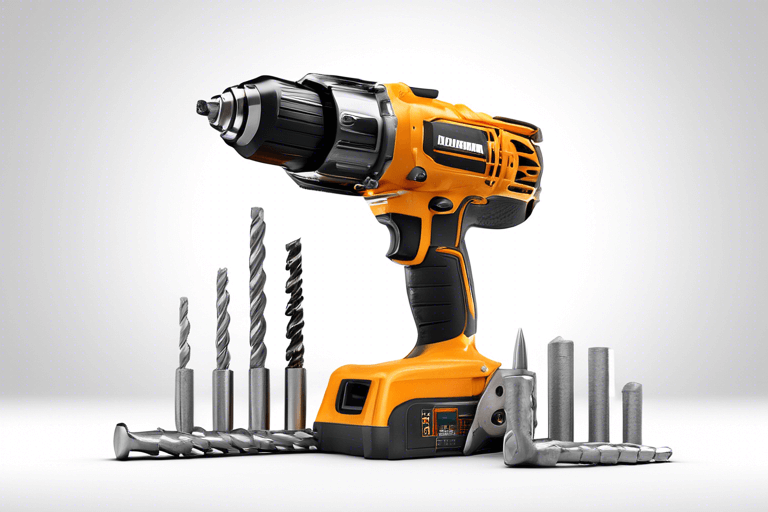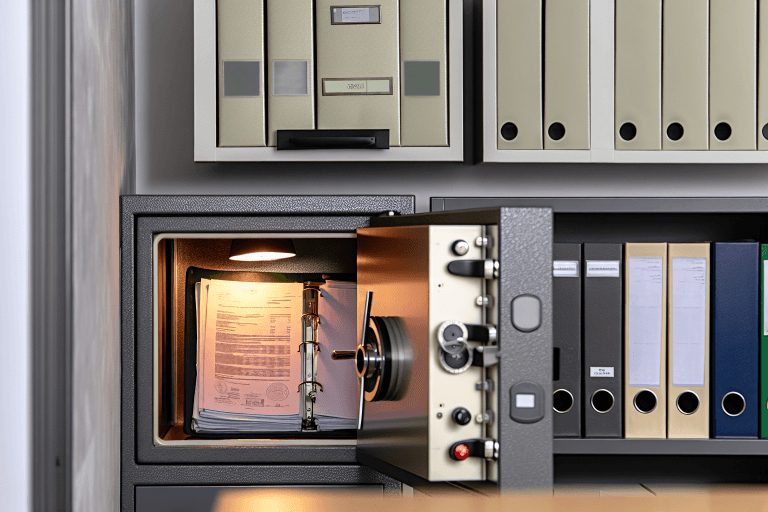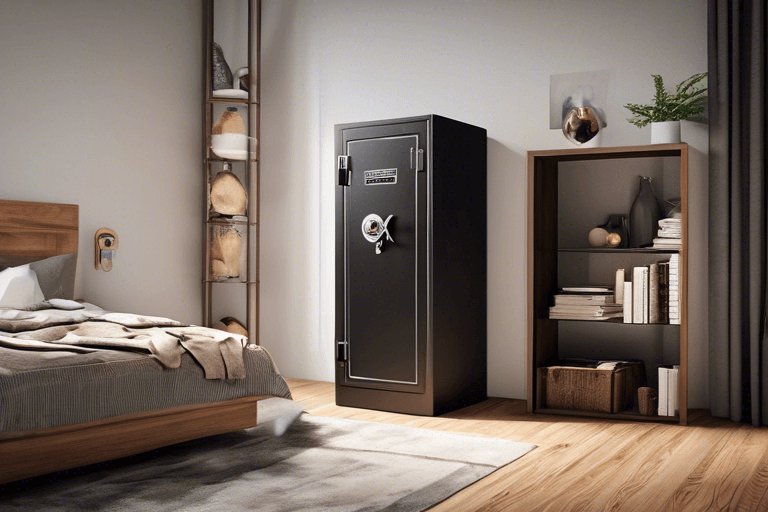
How to Install Anchor Bolts in Concrete for Your Safe
When it comes to safeguarding your most prized possessions, the security of your safe is paramount. After all, a safe is only as secure as its anchoring system.
Whether you've invested in a high-end gun safe or a sturdy home safe, ensuring it is properly anchored down or bolted to a wall can make all the difference in deterring potential thieves and preventing accidents.
In this guide, we'll delve into the intricacies of anchoring your safe to a concrete surface for either floor or wall installation, equipping you with the knowledge and confidence to undertake this crucial task.
Understanding the Importance of Anchoring Your Safe
Anchoring your safe to the floor or wall serves multiple critical purposes.
Firstly, it helps prevent the safe from tipping over, which can not only cause damage to your home but also put your loved ones at risk of injury. An unanchored safe, especially a heavy one, can become a dangerous projectile if it were to topple.
Secondly, anchoring your safe makes it significantly more difficult for burglars to pry it open or cart it away, deterring potential theft. By bolting your safe down, you're adding an extra layer of security that can safeguard your valuables.
Proper anchoring can also protect your flooring from the weight and movement of the safe. Unanchored safes can scratch, dent, or even crush delicate flooring materials like hardwood, tile, or carpeting. By securing the safe in place, you can avoid these unsightly and potentially costly issues.
Choosing the Right Anchoring System
When it comes to anchoring your safe to a concrete floor or wall, the most reliable and secure option is to use concrete anchor bolts. These specialized fasteners are designed to expand and grip the concrete, providing a sturdy and long-lasting hold.
The key to a successful installation lies in selecting the appropriate anchor bolts and properly executing the installation process.
Drop-In Concrete Anchor Bolts
One of the most common and effective concrete anchor bolt systems is the drop-in anchor. These anchors consist of a tubular expansion shield and a solid, cone-shaped expander plug.
The shield has slotted sides and a smooth, flangeless top, allowing for either flush or countersunk installation. The bottom lip of the shield is tapered to maximize depth and holding power.
To install drop-in concrete anchor bolts, you'll need to follow these steps:
- Drill a hole in the concrete using a hammer drill and a carbide-tipped masonry drill bit. The bit size should match the outside diameter of the drop-in anchor.
- Clear the hole of all debris to ensure a secure fit.
- Drive the anchor into the hole until it is flush with the concrete surface.
- Using the proper-sized setting tool, expand the anchor by inserting the tool and striking it with several solid hammer blows. The anchor is properly set when the shoulder of the setting tool is flush with the top of the anchor.
Wedge Anchor Bolts
Another popular option for anchoring a safe to concrete is the wedge anchor bolt. These anchors feature an expandable sleeve that grips the concrete as the bolt is tightened.
Wedge anchors are known for their high shear and tensile strength, making them an excellent choice for securing heavy safes.
The installation process for wedge anchor bolts is similar to that of drop-in anchors:
- Drill a hole in the concrete using a hammer drill and the appropriate masonry drill bit.
- Clear the hole of any debris.
- Insert the wedge anchor bolt into the hole and tighten it with a wrench or socket set. As the bolt is tightened, the expandable sleeve will grip the concrete, providing a secure hold.
Epoxy Anchor Bolts
For added security and a permanent bond, you may consider using epoxy anchor bolts. These anchors are designed to be embedded in a hole filled with a specialized epoxy adhesive. The epoxy creates a strong, chemical bond between the anchor and the concrete, making it an exceptionally secure option.
To install epoxy anchor bolts:
- Drill a hole in the concrete using a hammer drill and the correct masonry drill bit.
- Clean the hole thoroughly to remove any dust or debris.
- Inject the epoxy adhesive into the hole, filling it to the appropriate depth.
- Insert the epoxy anchor bolt and allow the adhesive to cure according to the manufacturer's instructions.
Preparing the Safe and the Installation Site
Before you begin the anchoring process, it's crucial to properly prepare both the safe and the installation site. This will ensure a smooth and successful installation.
Accessing the Anchor Bolt Holes
Most safes come equipped with pre-drilled anchor bolt holes located either on the interior floor of the unit or on the rear wall, or sometimes both. These holes provide convenient access points for securing the safe to the concrete.
Here we'll assume that you are anchoring the safe to a concrete floor, as opposed to a wall. Begin by removing any protective covers or caps that may be covering the holes.
Positioning and Leveling the Safe
Place the safe in the desired location on the concrete floor. Use a level to ensure the safe is perfectly level, adjusting it with shims if necessary. This step is essential for the proper alignment and functioning of the safe's door and locking mechanism.
On the concrete, mark the locations to be drilled through the anchor holes of the safe.
Concrete Surface Preparation
Ensure the concrete surface is clean and free of any debris, dust, or contaminants. This will allow the anchor bolts to achieve maximum grip and holding power.
Use a vacuum or a stiff-bristle brush to thoroughly clean the area where the safe will be anchored.
Drilling the Anchor Bolt Holes
Now it's time to start drilling the anchor bolt holes in the concrete. This step requires the use of a high-quality hammer drill and the appropriate masonry drill bit.
For particularly large safes, you can drill through the anchor holes with the safe already positioned in place. For smaller safes, simply move the unit to the side whilst you drill the holes.
Selecting the Correct Drill Bit
The size of the drill bit you use should match the outer diameter of the anchor bolts you have chosen. Refer to the manufacturer's specifications or the instructions provided with your anchoring system to determine the correct bit size.
Drilling the Holes
Using the hammer drill, carefully drill the anchor bolt holes into the concrete floor. Ensure the holes are drilled to the minimum depth recommended by the anchor bolt manufacturer. This depth is typically slightly deeper than the length of the anchor bolt itself.
Clearing the Holes
Once the holes have been drilled, use a strong vacuum or a compressed air canister to thoroughly remove any concrete dust or debris from the holes. This will ensure a secure fit for the anchor bolts.
Installing the Anchor Bolts
With the holes drilled and cleaned, it's time to install the anchor bolts. Depending on the type of anchoring system you've selected, the installation process may vary slightly.
Drop-In Anchor Bolts
For drop-in anchor bolts, begin by driving the anchor into the hole until it is flush with the concrete surface. Then, use the appropriate setting tool and a hammer to expand the anchor, locking it into place. The anchor is properly set when the shoulder of the setting tool is flush with the top of the anchor.
Wedge Anchor Bolts
To install wedge anchor bolts, simply insert the bolt into the drilled hole and tighten it with a wrench or socket set. As the bolt is tightened, the expandable sleeve will grip the concrete, securing the anchor in place.
Epoxy Anchor Bolts
For epoxy anchor bolts, start by injecting the specialized epoxy adhesive into the drilled hole, filling it to the appropriate depth. Then, insert the anchor bolt and allow the epoxy to cure according to the manufacturer's instructions.
Securing the Safe to the Anchor Bolts
With the anchor bolts in place, it's time to secure the safe to the floor. This process may vary depending on the specific safe model and the anchoring system you've chosen.
Aligning the Safe
Carefully position the safe over the installed anchor bolts, ensuring the pre-drilled holes in the safe's floor align perfectly with the bolts.
Attaching the Safe
Depending on the anchoring system, you may need to use washers, nuts, or other hardware to secure the safe to the anchor bolts. Consult the manufacturer's instructions or a professional installer to ensure the safe is properly attached.
Tightening the Connections
Once the safe is in place, use the appropriate tools (such as a socket set or torque wrench) to tighten the connections between the safe and the anchor bolts. This will create a secure, immovable bond that will deter theft and prevent accidents.
Finishing Touches
After the safe has been successfully anchored, there are a few final steps to complete the installation process.
Replacing Protective Covers
If your safe came with protective caps or covers for the anchor bolt holes, be sure to replace them. This will not only maintain the aesthetic of your safe but also help prevent debris from accumulating in the holes.
Verifying the Installation
Conduct a final inspection of the anchored safe, ensuring all connections are tight and the safe is securely in place. Test the door and locking mechanism to confirm they are functioning properly.
Registering the Safe
Many safe manufacturers offer registration programs that provide additional warranty coverage and security features. Be sure to register your safe according to the manufacturer's instructions to take advantage of these benefits.
Your Safe is Only as Strong as its Anchoring System
Anchoring your safe to a concrete floor is a critical step in keeping your valuables and important documents safe at home, as well as ensuring the overall safety of your home or business. By following the detailed guidance provided in this guide, you can confidently tackle this important task and rest assured that your prized possessions are securely protected.
Remember, the security of your safe is only as strong as its anchoring system. By investing the time and effort to properly install concrete anchor bolts, you're taking a proactive step in deterring theft and preventing accidents. With the right tools, techniques, and a little bit of know-how, you can transform your safe into an impenetrable fortress, giving you the peace of mind you deserve.



